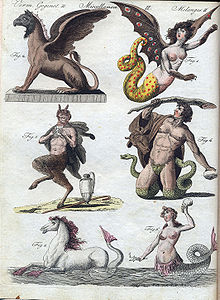Mythical creatures
Mythical creatures are creatures whose outward appearance is shaped by human imagination and whose existence could not be proven. These are human beings, animals, spirits or hybrid beings (chimeras) who play an important role in fairy tales , fables , mythology and heraldry , for example the Minotaurs , the Cyclops or the Centaurs .
Most mythical creatures are now considered to be the imaginary of the people of their time. Nevertheless, many have their origins in the real world: For example, it is assumed that in earlier times seafarers reinterpreted manatees as mermaids or mermaids and that mammoth bones found by chance were assigned to giants. In a few cases, a regional “mythical animal” has even proven to be a real animal in recent research. Examples of this are the okapi in the Congo region, the moas and the bridge lizard in New Zealand and finally the Saola in Vietnam.
Rarities and mythical creatures held a special place in the princely chambers of curiosities , which emerged from the 16th century. For example, Conrad Gessner drew dragons and unicorns that truly exist in the Alps. This was to represent the riches of God's nature.
The best-known modern mythical creatures include Mothman and the Jersey Devil or cryptids like Bigfoot and the Loch Ness Monster .
See also
Web links
Individual evidence
- ↑ Harald Gebhard, Mario Ludwig : Of dragons, yetis and vampires. On the trail of mythical animals. blv, Munich 2005, ISBN 3-405-16679-9 , p. 164 ff.

